Trenton III (LPD-14)
1971–2007
The capital city of New Jersey and of Mercer County, located at the head of navigation on the Delaware River, about 28 miles northeast of Philadelphia, Pa. On Christmas night 1776, General George Washington led the remnants of the Continental Army across the Delaware River in a blinding snow storm. At dawn on 26 December, he surprised and defeated the Hessian garrison at Trenton, inflicting nearly 1,000 casualties and capturing substantial supplies and ordnance. More importantly, his victory revived the cause of independence which had suffered greatly during his retreat from New York following the Battle of Long Island the previous August.
The third U.S. Navy ship named Trenton. The first Trenton, a wooden-hulled screw steamer, served with some brief interruptions from 1877-1891. The second Trenton, a light cruiser (CL-11), served from 1924-1946. The fourth Trenton, a joint high speed vessel (JHSV-5), is under construction and scheduled to be placed in service later in 2015.
See Trenton (LPD-14) for her Command Operations Reports.
III
(LPD-14: displacement 16,590; length 570'; beam 100'; draft 22'; speed 31 knots; complement 508; troop capacity 1,436; armament 8 3-inch; class Austin)
The third Trenton (LPD-14) was laid down on 8 August 1966, at Seattle, Wash., by the Lockheed Shipbuilding & Construction Co.; launched on 3 August 1968; sponsored by Mrs. Elizabeth M. Hughes, wife of Governor Richard J. Hughes of N.J.; and commissioned on 6 March 1971, Capt. Karl R. Thiele in command.
Trenton sailed on 9 April 1971 for the east coast and reached her home port of Norfolk, Va., on 12 May. The amphibious transport dock remained in port until 1 June, when she set out from Hampton Roads, Va., for shakedown training out of Guantánamo Bay, Cuba. Tragically, on 28 June, the main guarding valve in her number two engine room ruptured, killing four sailors instantly and severely injuring six others. A helicopter evacuated the injured men to Guantánamo Bay, and a USAF McDonnell Douglas C-9A Nightingale then flew them to the burn ward of the Army Hospital at Fort Sam Houston, Texas. There, two of the six sailors subsequently died as a result of their injuries. The ship returned on one boiler and one engine to Guantánamo Bay.
Following interim repairs, Trenton departed Guantánamo and made her way back to Norfolk on one engine, reaching that port on 6 July. She completed repairs at Norfolk Naval Shipyard, and then carried out shakedown training off the Virginia capes and in the Guantánamo Bay operating area. On 9 November, the ship returned to Norfolk and remained there through the end of 1971. On 17 January 1972, Trenton rounded Cape Charles and headed north to participate in cold weather amphibious exercise Snowy Beach. She arrived off Reid State Park, Maine, three days later and participated in the exercise until 23 January, when she came about for home. On 4 February, she stood out of Hampton Roads bound for the Gulf of Mexico in company with amphibious transport dock Ponce (LPD-15). The two ships reached New Orleans, La., on 9 February and, for the next six days, served as “hotel” ships for ROTC and military participants in the Mardi Gras Festival.
Trenton returned to Norfolk on 20 February 1972 and resumed her east coast-West Indies routine. Following amphibious training at Onslow Beach, N.C., and sea trials near Norfolk, she visited the Caribbean in April with other ships of Amphibious Squadron (PhibRon) 4. She then devoted the rest of the early summer to exercises and training at Onslow Beach and at Norfolk, before preparing for her first Mediterranean deployment.
The ship deployed from Norfolk on 28 July 1972, embarked Marines at Morehead City, N.C., the following day, and crossed the Atlantic, reaching Rota, Spain, on 10 August and, with the rest of PhibRon 4, was incorporated into the Sixth Fleet as Task Force (TF) 61. She spent the remainder of the year and most of the first month of 1973 in the Mediterranean. During that six-month period, Trenton participated in six amphibious landing exercises (Phiblex’s), most of them in cooperation with foreign military services. In September, she conducted a landing exercise at Timbakion, Crete, with the Italian Navy. Greek and Italian ships joined her later that month for Phiblex 3-73 at Alexandroupolis, Greece. In mid-October, French Foreign Legionnaires provided the opposition for a landing exercise at Corsica. Trenton visited Izmir, Turkey, in mid-September and, in mid-December, concluded her exercise schedule at Porto Scuda, Sardinia, with Phiblex 6-73. On 16 January 1973, she headed home, entering Naval Amphibious Base Little Creek, Va., ten days later.
On 1 March 1973, Trenton shifted to the administrative command of PhibRon 10. On 27 March, she embarked Marines at Morehead City and headed for Onslow Beach, where she participated in exercise Exotic Dancer VI. On 7 April, the warship steamed southward to Vieques Island, near Puerto Rico. From 10 to 14 April, Trenton joined other Navy ships in Escort Tiger XIV, which consisted of training for disaster assistance to the island countries of the Caribbean. During this voyage she visited Maracaibo, Venezuela; San Juan, Puerto Rico; and St. Thomas in the Virgin Islands, before embarking the Marines at Vieques on 3 May. After a port visit at Ponce, Puerto Rico, Trenton carried her leathernecks to Guantánamo Bay for a four-day exercise. On 14 May, she came about from the Caribbean and, after disembarking the Marines on 17 May, reached Norfolk the next day.
Trenton steamed out of Hampton Roads for northern Europe on 11 June 1973, reaching Kiel, Germany, on 22 June to participate in the annual “Kiel Week” naval celebration. Early in July, she visited Portsmouth, England, and, at mid-month, put into Rotterdam in the Netherlands. The amphibious transport dock bade farewell to Europe at Rotterdam on 21 July and headed back to the United States. Trenton spent the remainder of the summer accomplishing drills in the Virginia capes operating area, and preparing for her second Caribbean deployment of the year. On 1 October, she shifted from PhibRon 10 to PhibRon 8. On the last day of that month, she embarked Marines at Morehead City and turned south. For the remainder of the year, she cruised the Caribbean, visiting ports in Puerto Rico, the Virgin Islands, and in the Netherlands Antilles, as well as conducting amphibious exercises at Vieques Island. The ship returned to Norfolk on 14 December.
During the first four months of 1974, Trenton conducted operations out of Little Creek and Norfolk, while preparing for duty with the Sixth Fleet in the Mediterranean. On 10 May, she embarked Marines at Morehead City and put to sea. Ten days later, she reached Rota, Spain. For the next six months, she patrolled the Mediterranean, visiting ports and conducting exercises.
Greek Cypriot factions seeking union with Greece overthrew Archbishop Makarios on Cyprus, on 15 July 1974. On 22 July U.S. Ambassador to Cyprus Rodger P. Davies (who would, tragically, be slain by gunfire less than a month later, on 19 August, when a mob assaulted the U.S. Embassy in Nicosia) requested the evacuation of U.S. citizens. Attack aircraft carrier America (CVA-66) augmented the Sixth Fleet, and Forrestal (CV-59) provided air cover while Boeing Vertol CH-46F Sea Knights of Marine Medium Helicopter Squadron (HMM) 162, embarked on board amphibious assault ship Inchon (LPH-12), evacuated 466 people including 384 Americans from Dhekelia to amphibious transport dock Coronado (LPD-11). Additional evacuation ships included Trenton and dock landing ship Spiegel Grove (LSD-32).
On the evening of 19 July 1974 a USMC Sikorsky CH-53D Sea Stallion lifted off from Trenton en route to Inchon following night landing training for pilots. Shortly after taking-off, the Sea Stallion crashed into the sea off the ship’s port bow. Sailors and Marines rescued three of the seven men on board the helo, two of whom subsequently recovered. Trenton marked the crash datum and searched for nearly ten hours, but the other four men were never recovered.
Trenton and British aircraft carrier Hermes (R.12) meanwhile proceeded to Akrotiri, Cyprus. On 24 July 1974 Trenton and Hermes evacuated an additional 286 people including 114 Americans from Akrotiri, utilizing medium landing craft and Westland Sea King HAS.1/2 helicopters from No. 814 Squadron and Westland Wessex HU.5s from a detachment of No. 845 Squadron operating from Hermes. Coronado and Trenton disembarked the evacuees in Beirut, Lebanon. The Sixth Fleet forces deployed for the crisis operated at a high state of readiness until their release from contingency tasking on 2 September.
In the interim, Trenton came about from her Cypriot operations and visited Brindisi, Italy (4-10 August 1974), following by a “training anchorage” at that port through 22 August. During the 1st and 2nd dog watches on 13 August, one of the ship’s LCM-8s (mechanized landing craft) departed Trenton for the fleet landing. A fresh wind of about ten knots blew along the axis of the wharf from the boat’s starboard to port sides. At approximately 1800, Seaman J. P. Medeiros, the coxswain, turned the LCM-8 to starboard to parallel the wharf, but the wind appeared to twist her stern aft and set it down onto a small wooden motor craft, Maria Grazia, owned by Cosimo Gioia, an Italian fisherman. The LCM-8 struck the Italian boat’s port quarter, about four to five feet from her stern, slamming the boat into the wall of the wharf. Fenders protected both vessels and combined with the U.S. landing craft’s slow speed of three to four knots reduced Maria Grazia’s damage to cracking six strakes on her port quarter. Fortunately, no one was injured in the collision, but Maria Grazia required repairs in dry dock.
While with the Sixth Fleet, Trenton also participated in four amphibious exercises. One, Good Friendship/Double Effect, included Turkish ships. On 20 October 1974, she steamed out of Rota to return to the United States, reaching Norfolk on 31 October. The ship operated in the western Atlantic through the end of the year.
Trenton embarked Marines at Morehead City and headed south on 7 March 1975. After an amphibious assault exercise at Onslow Beach from 8 to 10 March, she continued to the Caribbean. During the two-month cruise, Trenton participated in four exercises, two of them, LantReadEx 2-75 and Rum Punch, in cooperation with the British and Dutch navies. She returned to Norfolk on 28 April. In May, she hosted a class from the Naval War College, conducted a midshipman training cruise for the Naval Academy, and returned to Onslow Beach for joint service exercise Solid Shield. During the early summer, Trenton prepared for overhaul. On 14 August, she headed north to New York, moored at Coastal Drydock & Repair Co., the next day, and began a nine-month overhaul.
On 12 May 1976, Trenton emerged from yard hands and, following load-out at Little Creek, Va., deployed to Guantánamo Bay, Cuba, on 6 July for refresher training. Returning to Norfolk on 17 August, she deployed to the Mediterranean on 15 November, embarking Marines of Marine Battalion Landing Team 1/6. The ship operated with Mediterranean Amphibious Ready Group 3-76 until she returned to Norfolk on 12 May 1977. Trenton spent the remainder of 1977 conducting midshipman training cruises, engaging in amphibious exercises, and participating in CompTuEx 3-77, which involved NATO’s Standing Naval Force Atlantic.
The year 1978 found Trenton embarking Marines of Battalion Landing Team 1/2 and deploying to the Caribbean, from 30 January to 7 March, to participate in Atlantic Fleet Readiness Exercise 1-78. She spent the succeeding four months preparing to return to the Mediterranean. The ship, with Marine Battalion Landing Team 2/8 embarked, steamed from Morehead City on 27 July as part of Mediterranean Amphibious Ready Group 2-78. She operated as part of the Sixth Fleet in that sea during the remainder of 1978.
An Iranian mine damaged guided missile frigate Samuel B. Roberts (FFG-58) in the Persian Gulf on 14 April 1988. The vessels that assisted included Trenton. On 18 April, the U.S. launched Operation Praying Mantis: retaliation against the Iranian-occupied Rakhsh, Salman (Sassan), and Sīrrī-D (Nassr) oil platforms.
TWA Flight 800, a Boeing B-747-100, en route from John F. Kennedy International Airport to Leonardo da Vinci International Airport, Rome, Italy, crashed into the Atlantic shortly after take-off on 17 July 1996, killing all 230 people on board. Trenton joined multiple Navy aircraft, divers, and ships, including dock landing ship Oak Hill (LSD-51), salvage ships Grapple (ARS-53) and Grasp (ARS-51), destroyer tender Shenandoah (AD-44), and submarine tenders Emory S. Land (AS-30) and L. Y. Spear (AS-36), that searched for survivors during the tragedy.
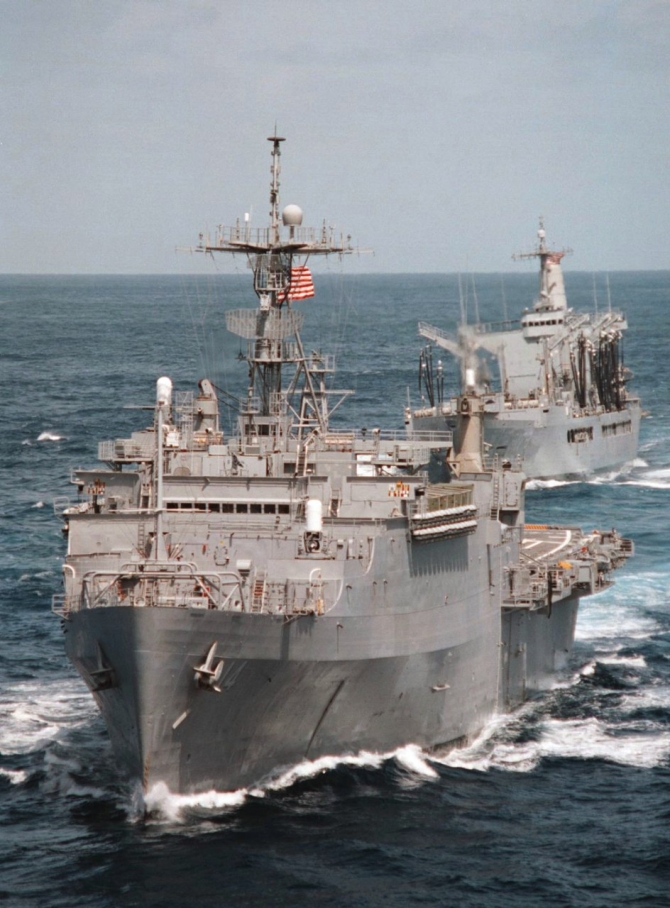
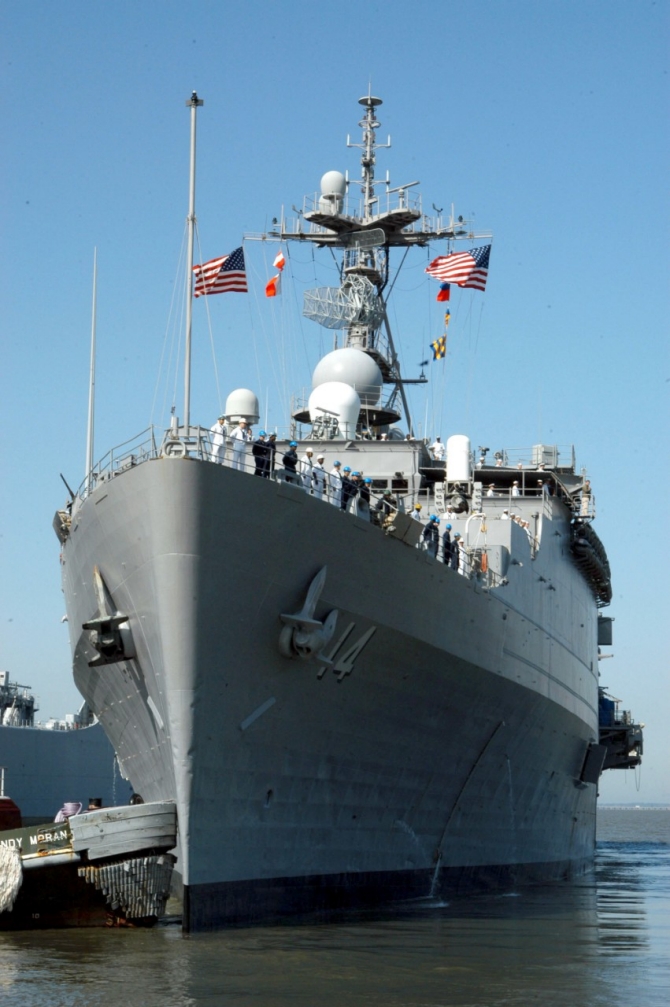
During 2006, Hezbollah forces attacked Israeli settlements with rockets and the Israelis thus began Operation Change of Direction: to drive the terrorists from Israel’s northern borders. On 16 July 2006, amphibious assault ship Iwo Jima (LHD-7), amphibious transport dock Nashville (LPD-13), and dock landing ship Whidbey Island (LSD-41), with the 24th Marine Expeditionary Unit embarked, received orders to come about from the Red Sea and operate as part of Task Force (TF) 59 for what expanded into Operation Strengthen Hope: the evacuation of Americans from Lebanon. On 23 August, European Command directed Joint Task Force Lebanon to take over the mission performed by TF 59, and by USAF Lockheed MC-130P Combat Shadows and Sikorsky MH-53M Pave Lows, and USA Boeing Vertol CH-47 Chinooks. Vice Adm. John D. Stufflebeem broke his flag in command of the force from command ship Mount Whitney (LCC-20). Nashville evacuated people from the fighting, including Chef Anthony Bourdain and his crew from the show No Reservations. Fans dubbed the ensuing clip “The Shwarma and Shrapnel Episode” (Shwarma is a sandwich-like wrap of Middle Eastern origin). Amphibious assault ship Wasp (LHD-1), with Helicopter Mine Countermeasures Squadron 14 Detachment 1 embarked, began a surge deployment to the area from Norfolk, Va., on 25 August. Additional ships that took part included Trenton. The force evacuated nearly 15,000 Americans, and provided humanitarian assistance to victims of the fighting.
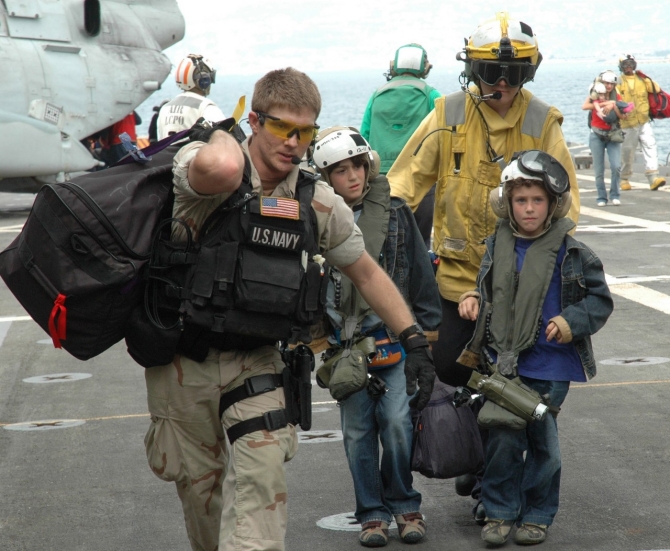
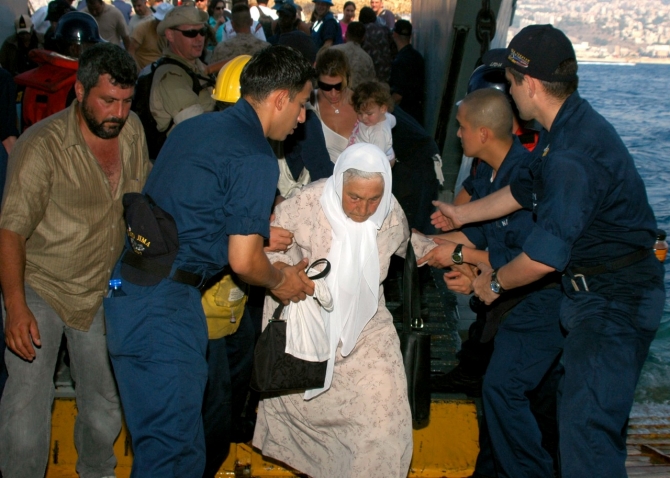
Trenton was stricken, decommissioned, and transferred to the Indian Navy on 17 January 2007 at Norfolk, and renamed Jalashwa (L.41).
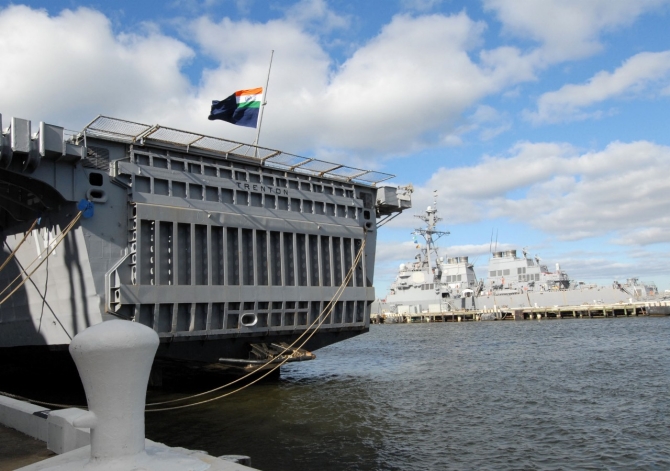
Detailed history under construction.
Mark L. Evans
17 March 2015


